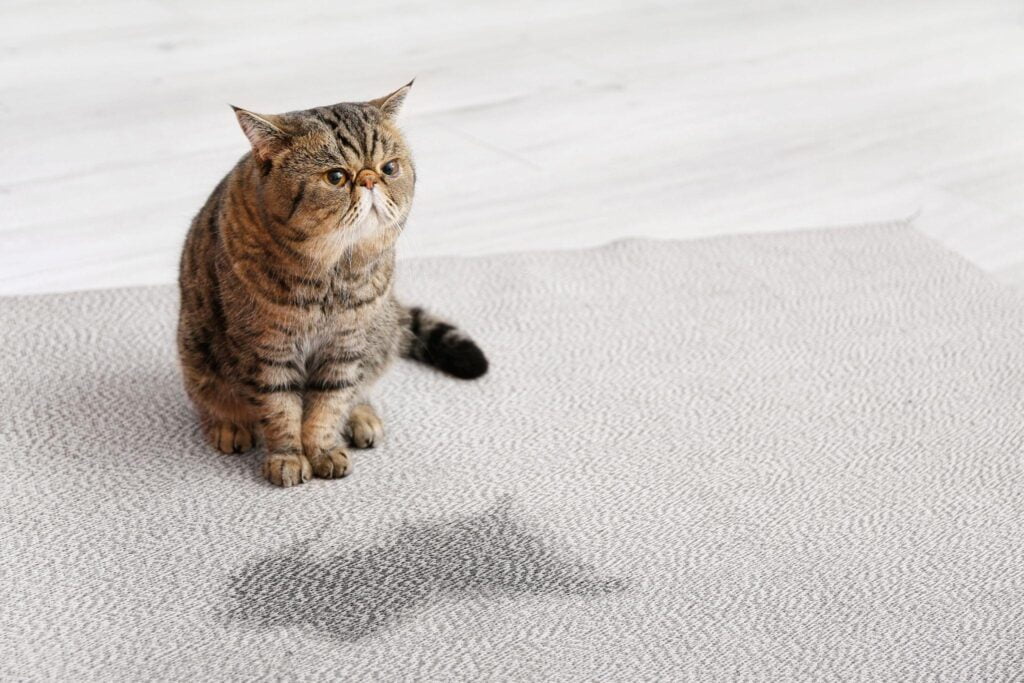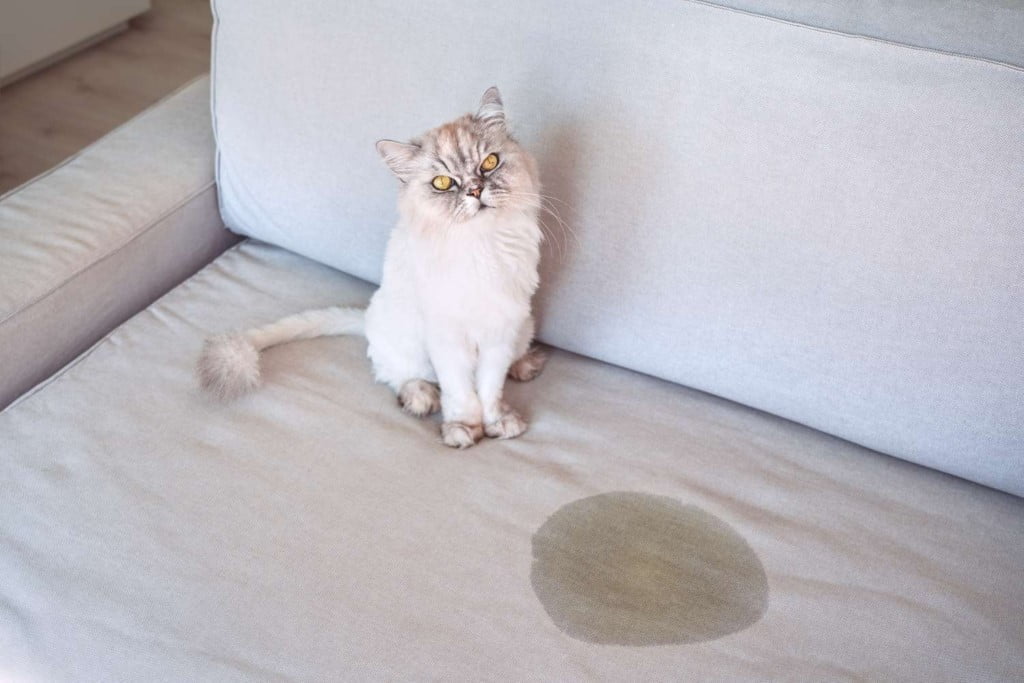How to Clean Cat Pee With Vinegar in 5 Easy Steps

Cleaning up cat pee can be a daunting task, especially if it has been left for too long. Not only does it leave behind unsightly stains, but the smell can linger for weeks, even after cleaning. But, there’s no need to resort to harsh chemicals or expensive cleaning solutions. There is a far easier method which we will discuss in this article: How to clean cat pee with vinegar.
Vinegar is a natural, safe, and effective way to clean cat pee and remove the accompanying smelly odor. In this ultimate guide, we will show you how to clean cat pee with vinegar in 5 simple steps and get your home smelling fresh and clean again.
Why You Should Clean Cat Pee with Vinegar
Cleaning cat pee can be a challenging task that many cat owners face. The strong odor, persistent stains, and the difficulty of completely eliminating the smell can make it a frustrating experience. However, cleaning cat pee with vinegar offers several advantages against these problems:
- Natural and non-toxic: Vinegar is a safe cleaning solution for both pets and humans, eliminating the worry of exposing them to harsh chemicals.
- Effective odor and stain remover: Vinegar effectively breaks down the compounds in cat urine and is perfect against cat pee that smells too strong, providing an efficient solution for tackling cat pee accidents.
- Cost-effective: Vinegar is a budget-friendly option for cleaning up after your cat, as it is readily available and affordable compared to specialized cleaning products.
- Versatile usage: Vinegar can be used on various surfaces such as carpets, hardwood floors, and upholstery, making it a versatile solution for multiple cleaning tasks around the house.
Here’s a step-by-step guide on how you can clean cat pee with vinegar:
Step 1: Blot up as much of the urine as possible

When it comes to cleaning cat pee, the first step is to take swift action and blot up as much of the urine as possible. Grab a clean cloth or a stack of paper towels and gently press down on the affected area. The goal is to absorb as much of the urine as you can before it has a chance to seep deeper into the surface.
Remember, time is of the essence here. The longer the urine sits, the more challenging it becomes to remove both the stain and the odor. So, don’t delay in tackling this task.
Be sure to use firm pressure while blotting, but avoid rubbing or scrubbing vigorously, as this may spread the urine and worsen the stain. Patience is key, as you want to gradually absorb the liquid without pushing it further into the material.
Once you’ve successfully blotted up as much urine as possible, you can proceed to the next step in our comprehensive guide to conquer cat pee cleaning.
Step 2: Mix a cleaning solution of equal parts white vinegar and water

With the initial urine blotting complete, it’s time to create a powerful cleaning solution to tackle the remaining stain and odor. In a spray bottle, combine equal parts white vinegar and water. This simple yet effective mixture harnesses the acidic properties of vinegar to break down the urine and eliminate the unpleasant smell.
For instance, if you use one cup of water, be sure to add one cup of white vinegar. The combination of these two ingredients forms a potent solution that will help neutralize the cat pee and restore freshness to the affected area.
To enhance the fragrance, you can even add a few drops of your favorite essential oil into the mix. This additional touch not only masks any remaining odor but also leaves a pleasant scent behind. With your vinegar and water solution ready to go, you’re one step closer to a clean and odor-free environment. Let’s move on to the next step for a comprehensive guide to successfully dealing with cat pee.
Step 3: Spray the cleaning solution on the affected area

Now that you have your vinegar and water solution prepared, it’s time to tackle the cat pee stain head-on. Take the spray bottle filled with the cleaning solution and generously spray it over the affected area. Ensure that you cover the entire area thoroughly, as this will help to effectively loosen the urine and combat the odor.
Before proceeding, it’s crucial to test the cleaning solution on a small, inconspicuous area of the surface. This step ensures that the vinegar solution won’t cause any damage or discoloration to the material. Once you’ve confirmed the compatibility, you can proceed with confidence, knowing that the cleaning solution will effectively address the cat pee problem.
With the affected area properly saturated with the vinegar and water solution, you’re one step closer to restoring cleanliness and freshness to your surroundings. Continue reading to discover the next steps in our comprehensive guide to successfully dealing with cat pee.
Step 4: Blot up the cleaning solution and urine

With the cleaning solution applied, it’s time to tackle the next crucial step in the cleaning process. Take clean cloths or paper towels and begin blotting up the cleaning solution and urine from the affected area. Apply firm pressure to the cloth to ensure maximum absorption of the solution and urine.
By blotting, you are effectively removing the remnants of the cleaning solution and urine from the surface. This step is vital in preventing further staining and lingering odors. Continue blotting until you no longer see any traces of urine or cleaning solution on the cloth.
Remember to use different sections of the cloth or switch to a new cloth as needed to maintain cleanliness and avoid spreading the stain. With each blot, you’re closer to eliminating the unsightly cat pee and achieving a fresh and clean space. Stay tuned for the next steps in our comprehensive guide to effectively dealing with cat pee.
Step 5: Allow the area to dry

After blotting up the cleaning solution and urine, it’s important to allow the area to dry completely. This will ensure that any remaining moisture is evaporated, preventing the growth of mold or mildew. It’s best to leave the area uncovered and provide good airflow, such as opening windows or using fans, to expedite the drying process.
During the drying period, keep pets and children away from the area to prevent any accidents or disturbances. You can also place a clean towel or absorbent material over the spot to absorb any residual moisture.
If the stain or odor persists after the first cleaning, it may be necessary to repeat the process. Some older or stubborn stains may require multiple cleanings to completely remove them. Be patient and persistent, and remember that consistency is key to effectively cleaning cat pee.
Tips to prevent future accidents:

- Provide a clean litter box: Ensure that your cat has access to a clean litter box at all times. Regularly scoop the litter box and replace the litter as needed. Also make sure there is no residual smell in the litterbox.
- Multiple litter boxes: If you have multiple cats, provide each cat with their own litter box and consider adding an extra one. This can help prevent competition or territorial issues.
- Litter box attractant: Consider using a litter box attractant, which can help entice your cat to use the litter box. These attractants are available in various forms, such as sprays or additives for the litter.
- Monitor your cat’s health: Keep an eye on your cat’s behavior and look for signs of urinary tract infection or other health issues that may lead to accidents. If you notice any changes, consult your veterinarian.
- Hydration and diet: Ensure your cat is adequately hydrated by providing fresh water at all times. Additionally, feed them a balanced diet that meets their nutritional needs.
- Mental and physical stimulation: Engage your cat in regular playtime and provide interactive toys to keep them mentally and physically stimulated. A bored cat may be more prone to accidents.
In addition to following these preventive measures, it’s essential to use a pet-specific enzymatic cleaner to remove any remaining stains and odors. These cleaners are specifically formulated to break down the proteins found in urine, effectively eliminating stubborn stains and odors. By incorporating these tips into your routine, you can minimize the chances of future accidents and maintain a clean and fresh environment for both you and your feline companion.
Conclusion:
Using vinegar to clean cat pee is a safe and effective method that will not only remove the odor and stain but also prevent them from recurring. The acidic nature of the vinegar helps to break down the toughest and darkest urine stains and also remove the odor.
The process is simple and can be done with items you likely already have on hand. With this ultimate guide, you will be able to clean cat pee with vinegar and get your home smelling fresh and clean again.


